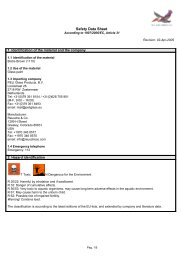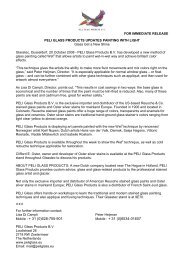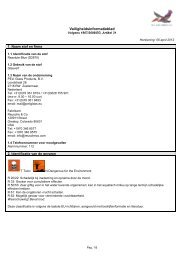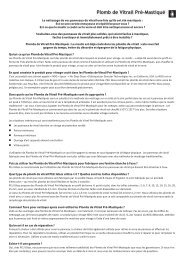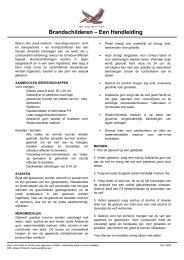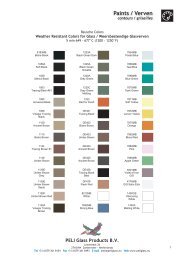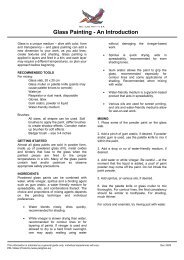HG9004 Orange - PELI Glass Products BV
HG9004 Orange - PELI Glass Products BV
HG9004 Orange - PELI Glass Products BV
Create successful ePaper yourself
Turn your PDF publications into a flip-book with our unique Google optimized e-Paper software.
Safety Data Sheet<br />
According to 1907/2006/EC, Article 31<br />
Revision: 20-Apr-2009<br />
1. Identification of the material and the company<br />
1.1 Identification of the material<br />
<strong>Orange</strong> (<strong>HG9004</strong>)<br />
1.2 Use of the material<br />
<strong>Glass</strong> paint<br />
1.3 Importing company<br />
<strong>PELI</strong> <strong>Glass</strong> <strong>Products</strong>, B.V.<br />
Loodstraat 26<br />
2718 RW Zoetermeer<br />
Netherlands<br />
Tel: +31(0)79 361 8154 / +31(0)628 755 901<br />
(M-F, 9:00 – 16:00)<br />
Fax: +31(0)79 361 8493<br />
email: mail@peliglass.eu<br />
Manufacturer:<br />
Reusche & Co.<br />
1299 H Street<br />
Greeley, Colorado 80631<br />
USA<br />
Tel: +1970 346 8577<br />
Fax: +1970 346 8575<br />
email: info@reuscheco.com<br />
1.4 Emergency telephone<br />
Emergency: 112<br />
2. Hazard identification<br />
T Toxic<br />
N Dangerous for the Environment<br />
R 20/22: Harmful by inhalation and if swallowed.<br />
R 33: Danger of cumulative effects.<br />
R 50/53: Very toxic to aquatic organisms, may cause long-term adverse effects in the aquatic environment.<br />
R 61: May cause harm to the unborn child.<br />
R 62: Possible risk of impaired fertility.<br />
Warning! Contains lead.<br />
The classification is according to the latest editions of the EU-lists, and extended by company and literature data.<br />
Pag. 1/5
3. Composition / information on ingredients<br />
Dangerous components:<br />
Name Weight, %<br />
Alumina (as Al) 0 – 8<br />
Barium, soluble compounds (as Ba) 0 – 6<br />
Borates (as Bo) 0 – 8<br />
Cadmium compounds (as Cd) 8 – 18<br />
Inorg. Lead compounds (as Pb) 18 – 28<br />
Silica, quartz (free, as Si) 28 – 38<br />
Titanium (as Ti) 0 – 6<br />
Zinc compounds (as Zn) 0 – 6<br />
Zirconium compounds (as Zr) 0 – 8<br />
Other components:<br />
Frit (CAS# 65997-18-4)<br />
C.I. Pigment Yellow 35 (CAS# 8048-07-5)<br />
Barium sulfide (CAS# 7727-43-7)<br />
4. First aid measures<br />
General: Harmful if inhaled or swallowed. Repeated and prolonged inhalation may cause delayed injury.<br />
Inhalation: Remove to fresh air. Call a physician.<br />
Skin: Wash with mild soap and water. Call a physician.<br />
Eyes: Flush eyes with water for at least 15 minutes. Call a physician.<br />
Ingestion: If conscious, give large quantities of water or milk. Induce vomiting. Call a physician.<br />
Wash contaminated clothing prior to reuse.<br />
5. Fire fighting measures<br />
No special firefighting procedures required. Material will not burn, however, use water to cool metal containers. Toxic<br />
fumes may be evolved during a fire.<br />
6. Accidental release measures<br />
Use appropriate protective equipment during clean up. Vacuum, with an H.E.P.A. filter-equipped vacuum, or use wet<br />
clean-up techniques and place recovered product in a closable container. Do not dry sweep lead-containing dusts.<br />
7. Handling and storage<br />
Handling<br />
Use adequate localized ventilation for all handling operations. Use respirators equipped with dust, fume, and mist<br />
H.E.P.A. filter cartridges during all handling operations. Rubber gloves recommended. Protect eyes from dust particles,<br />
use safety glasses or goggles. Take necessary steps to avoid the contamination of footwear worn away from the work<br />
place. Keep away from food and food products. Wash hands after use.<br />
Storage<br />
Product has unlimited shelf life. Store in closed containers. Empty containers should not be reused except for similar<br />
glass paints and should be disposed of in accordance with regulations. No special requirements for storerooms.<br />
For manufacturing use only.<br />
Pag. 2/5
8. Exposure controls / personal protection<br />
Use adequate localized ventilation for all handling operations. Use respirators equipped with dust, fume, and mist<br />
H.E.P.A. filter cartridges during all handling operations. Rubber gloves recommended. Protect eyes from dust particles,<br />
use safety glasses or goggles. Take necessary steps to avoid the contamination of footwear worn away from the work<br />
place. Keep away from food and food products. Wash hands after use.<br />
Do not allow undiluted product or large quantities of it to reach ground water, surface water or sewage system.<br />
9. Physical and chemical properties<br />
General information<br />
Form: powder<br />
Color: orange<br />
Odor: odorless<br />
Important health, safety and environmental information<br />
Boiling point: not applicable<br />
Flame point: not applicable<br />
Flash point: not applicable<br />
Lower explosion limit: not applicable<br />
Upper explosion limit: not applicable<br />
Specific gravity (H 2O = 1): approx. 3.5<br />
Water solubility: insoluble<br />
pH: not applicable<br />
Viscosity: not applicable<br />
Vapor pressure (mm Hg): not applicable<br />
Vapor density (air = 1): not applicable<br />
Percent volatile by volume (%): 0<br />
Evaporation rate (BuAc = 1): not applicable<br />
Other information<br />
Melting point: approx. 630°C<br />
10. Stability and reactivity<br />
Stable. Hazardous polymerization will not occur.<br />
Conditions to avoid – not applicable<br />
Materials to avoid – not applicable<br />
Hazardous decomposition products – not applicable<br />
Pag. 3/5
11. Toxicological information<br />
Acute effects:<br />
Irritant effect on the skin: no irritant effect known.<br />
Irritant effect on the eye: no irritant effect known.<br />
Sensitization: No sensitizing effects known.<br />
Repeated and prolonged exposure to lead may cause delayed effects involving the blood, gastrointestinal, nervous and<br />
reproductive systems. Lead and lead compounds are known to the State of California to cause birth defects or<br />
reproductive harm.<br />
Repeated and prolonged exposure to cadmium compounds may cause delayed effects involving the respiratory and renal<br />
systems.<br />
Silica, crystalline (particles of respirable size), if listed as a component, are known to the State of California to cause<br />
cancer.<br />
12. Ecological information<br />
Product is expected to be very toxic for fish.<br />
Product is expected to be poisonous for fish and plankton in water bodies.<br />
Product is expected to be very toxic for aquatic organisms.<br />
13. Instructions for disposal<br />
Dispose of in accordance with regulations.<br />
14. Transport information<br />
Harmonized system code: 320710 (Prepared Pigments, Prepared Opacifiers, Prepared Colors, Similar Preparations)<br />
• Land transport ADR/RID (cross-border)<br />
ADR/RID class: 6.1 (T5) Toxic substance<br />
Kemler number: 60<br />
UN-Number: 3288<br />
Packing group: III<br />
Hazard label: 6.1<br />
Limited quantities (LQ): LQ9<br />
Description of goods: 3288 TOXIC SOLID, INORGANIC, N.O.S.<br />
• Sea transport IMDG<br />
IMDG Class: 6.1<br />
UN-Number: 3288<br />
Label: 6.1<br />
Packaging group: III<br />
Marine pollutant: no<br />
Proper shipping name: TOXIC SOLID, INORGANIC, N.O.S.<br />
Pag. 4/5
• Air transport ICAO-TI and IATA-DGR<br />
ICAO/IATA Class: 6.1<br />
UN-Number: 3288<br />
Label: 6.1<br />
Packaging group: III<br />
Proper shipping name: TOXIC SOLID, INORGANIC, N.O.S.<br />
15. Regulatory information<br />
T Toxic<br />
Risk phrases:<br />
R 20/22: Harmful by inhalation and if swallowed.<br />
R 33: Danger of cumulative effects.<br />
R 50/53: Very toxic to aquatic organisms, may cause long-term adverse effects in the aquatic environment.<br />
R 61: May cause harm to the unborn child.<br />
R 62: Possible risk of impaired fertility.<br />
Safety phrases:<br />
S 22: Do not breathe dust.<br />
S 36/37: Wear suitable protective clothing and gloves.<br />
S 45: In case of accident or if you feel unwell, seek medical advice immediately (show label where possible).<br />
S 53: Avoid exposure - obtain special instructions before<br />
use. Restricted to professional users.<br />
S 60: This material and its container must be disposed of as hazardous waste.<br />
S 61: Avoid release to the environment. Refer to special instructions / safety data sheets.<br />
The classification is according to the latest editions of the EU-lists, and extended by company and literature data.<br />
16. Other information<br />
This information is based on our present knowledge. However, this shall not constitute a guarantee for any specific<br />
product features and shall not establish a legally valid contractual relationship.<br />
Risk phrases:<br />
R 20/22: Harmful by inhalation and if swallowed.<br />
R 33: Danger of cumulative effects.<br />
R 50/53: Very toxic to aquatic organisms, may cause long-term adverse effects in the aquatic environment.<br />
R 61: May cause harm to the unborn child.<br />
R 62: Possible risk of impaired fertility.<br />
Pag. 5/5



